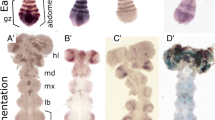Abstract
A description is given of the puffing sequences of the giant polytene chromosomes from the footpads of Sarcophaga bullata, from Day 3 to Day 12 of pupation at 25° C. The chromosome puffing patterns are seen to be very precise and to occur in orderly sequence with respect to general developmental events. Particular puffs appear or regress in a continuous, orderly sequence. A few puffs remain throughout adult development. Most are puffed for a limited time only. In several cases puffed regions appear to “move along” the chromosome, suggesting sequential activity of adjacent genetic loci. Attempts are made to correlate chromosome puffing with specific cellular activities — cell growth, the sequential secretion of six cuticular layers (determined by electron microscopy), cuticle sclerotization and melanization, and eventual cell death. Preliminary observation of thoracic trichogen cell chromosomes show interesting similarities and differences in puffing patterns, when compared with footpad sequences.
Similar content being viewed by others
Bibliography
Anderson, S. V., and T. Weis-Fogh: Resilin. In: Advances in insect physiology, vol. 2, p. 1–65. London and New York: Academic Press 1964.
Beermann, W.: Riesenchromosomen. Protoplasmatologia, vol. VI/D. Wien: Springer 1962.
Berendes, H. D.: Gene activities in the Malpighian tubules of Drosophila hydei at different developmental stages. J. exp. Zool. 162, 209–218 (1966).
Boyes, J. W.: Somatic chromosomes of higher Diptera. V. Interspecific and intraspecific variation in the Calliphoridae. Canad. J. Zool. 39, 549–570 (1961).
—: Somatic chromosomes of higher Diptera. VII. Sarcophagid species in relation to their taxonomy. Canad. J. Zool. 41, 1191–1204 (1963).
Clever, U.: Chromosomal changes associated with differentiation. In: Genetic control of differentiation. Brookhaven Symp. in Biol. 18, 242–253 (1965).
Hackman, R. H.: Chemistry of the insect cuticle. The physiology of the Insecta, vol. 3, p. 471–506. (ed. M. Rockstein). London and New York: Academic Press 1964.
Karlson, P.: Biochemical studies of ecdysone control of chromosomal activity. J. cell. comp. Physiol. 66, 69–76 (1965).
—, u. G. Peters: Zum Wirkungsmechanismus der Hormone. IV. Der Einfluß des Ecdyson auf den Nucleinsäurestoffwechsel von Calliphora Larven. Gen. comp. Endocr. 5, 252–259 (1965).
Karlson P. u. C. E. Sekeris: Kontrolle des Tyrosin-Stoffwechsels durch Ecdyson. Biochim. biophys. Acta (Amst.) 63, 489–495 (1962).
—, u. R. Maurer: Zum Wirkungsmechanismus der Hormone. 1. Verteilung von Tritium-markiertem Ecdyson in Larven von Calliphora erythrocephala. HoppeSeylers Z. physiol. Chem. 336, 100–106 (1964).
Kroeger, H., and M. Lezzi: Regulation of gene action in insect development. Ann. Rev. Entomol. 11, 1–22 (1966).
Mechelke, F.: Das Wandern des Activitätsmaximums im BR-locus von Acricotopus lucidus als Modell für die Wirkungsweise eines komplexen Locus. Naturwissenschaften 48, 29 (1961).
Pantin, C. F. A.: Notes on microscopical technique for Zoologists. Cambridge: University Press 1959.
Ribbert, D.: Die Polytänchromosomen der Borsten-Bildungszellen von Calliphora erythrocephala. Chromosoma (Berl.) 21, 296–344 (1967).
Steedman, H. F.: Ester Wax 1960: A histological embedding medium. Quart. J. micr. Sci. 101, 459–462 (1960).
Taylor, R. L., and A. G. Richards: Integumentary changes during molting of arthropods with special reference to the subcuticle and ecdysial membrane. J. Morph. 116, 1–22 (1965).
Ullerich, F. H.: Geschlechtschromosomen und Geschlechtsbestimmung bei einigen Calliphorinen (Calliphoridae, Diptera). Chromosoma (Berl.) 14, 45–110 (1963).
Weis-Fogh, T.: A rubber-like protein in insect cuticle. J. exp. Biol. 37, 889–907 (1960).
Whitten, J. M.: Giant polytene chromosome development in cells of the hypodermis and heart of fly pupae. Proc. 16th Internl. Congr. Zoology, Washington, p. 276 (1963).
—: Giant polytene chromosomes within hypodermal cells of the developing footpads of dipteran pupae. Science 143, 1437 (1964).
—: Differential deoxyribonucleic acid replication in the giant footpad cells of Sarcophaga bullata. Nature (Lond.) 208, 1019–1021 (1965).
- Coordinated development in the fly foot: sequential cuticle secretion. J. Morph. (in press, 1969a).
- Haemocyte activity in relation to hypodermal cell growth, cuticle secretion and cell death, in a metamorphosing cyclorrhaphan pupa. J. Insect Physiol. (in press, 1969b).
Author information
Authors and Affiliations
Rights and permissions
About this article
Cite this article
Whitten, J.M. Coordinated development in the foot pad of the fly Sarcophaga bullata during metamorphosis: changing puffing patterns of the giant cell chromosomes. Chromosoma 26, 215–244 (1969). https://doi.org/10.1007/BF00326457
Received:
Issue Date:
DOI: https://doi.org/10.1007/BF00326457




